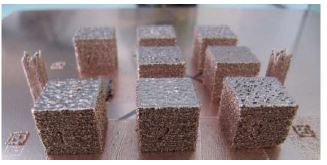LNF: Additive manufacturing of Copper alloys for the development of new Clean Energies (AFCE): Difference between revisions
(Created page with "== LNF - Nationally funded project == '''Title''': '''Additive manufacturing of Copper alloys for the development of new Clean Energies (AFCE)''' '''Reference''': Proyectos Transición Ecológica y Transición Digital '''Programme and date''': 2021 program '''Area/subarea''': Materials for energy '''Principal Investigator(s)''': Rebeca Hernández Pascual - Edgar León Gutiérrez '''Project type''': Individual project '''Start-end dates''': 01/12/2022 - 30/11/2024...") |
|||
| (7 intermediate revisions by the same user not shown) | |||
| Line 1: | Line 1: | ||
== LNF - Nationally funded project == | == LNF - Nationally funded project == | ||
'''Title''': '''Additive manufacturing of Copper alloys for the development of new Clean Energies (AFCE)''' | '''Title''': '''Additive manufacturing of Copper alloys for the development of new Clean Energies (AFCE-FACE)''' | ||
'''Reference''': | '''Reference''': TED2021-129825A-I00 | ||
'''Programme and date''': 2021 | '''Programme and date''': Proyectos Transición Ecológica y Transición Digital-2021 | ||
'''Area/subarea''': Materials for energy | '''Area/subarea''': Materials for energy | ||
| Line 13: | Line 13: | ||
'''Project type''': Individual project | '''Project type''': Individual project | ||
'''Start-end dates''': 01/12/2022 - 30/11/2024 | '''Start-end dates''': 01/12/2022 - 30/11/2024 (extended to 30/09/2025) | ||
'''Financing granted (direct costs)''': 149.155 € | '''Financing granted (direct costs)''': 149.155 € | ||
[[File:LOGO_FACE.png|200px|thumb|left|Caption]File:File.png|200px|thumb|right|Caption]] | |||
== Description of the project == | == Description of the project == | ||
The objective of the project is to optimize the parameters of the additive manufacturing of CuCrZr alloys for use in fusion reactors. The additive manufacturing of | The main objective of the project is to optimize the parameters of the additive manufacturing of CuCrZr alloys for use in fusion reactors using screening characterization techniques including also the elaboration of recommendations for the standardization of the manufacturing process. Indeed, the approach given to the project contributes to the ecological transition from different aspects. | ||
First, the production of fusion energy will be a powerful tool for drastically reducing greenhouse gas emissions. It will generate the energy infrastructure to enable drastic decarbonization would be necessary to meet the commitments of the Paris Agreement. The ITER (International Thermonuclear Experimental Reactor) programme is included on the NextGenerationEU programme under Heading 1: Single Market, Innovation and Digital and it is marked as 100% substantial that means that the activity’s expected results make a substantial contribution to climate mitigation. | |||
Copper alloys were selected as the best solution for some applications in the ITER and DEMO (the planned European Demonstrations Reactor) first wall and divertor. CuCrZr were selected as promising solution as heat sink material, mainly due to its high fracture toughness, availability and cost. In this context, the development, optimization and characterization of this material will provide an important boost in the development of fusion energy. | |||
Secondly, the use of additive manufacturing introduces another relevant perspective in contributing to the ecological transition. Different studies give the additive manufacturing of materials a relevant role in the circular economy, especially in the case of metals. Both by reducing the necessary material during fabrication to a minimum and by its recyclability. Finally, the use of small-punch (SP) as a screening technique is a powerful tool for increasing durability, reparability and the possibilities of action. On the one hand, it would minimize the necessary resources in the process of development and optimization of materials and would allow the monitoring of the mechanical properties of components in service, within their operational life. This will produce an increase in the durability of the materials and components. | |||
The FACE project proposes the use of the small punch tests as screening method to optimize the AM process parameters. The small punch test has in the last decade emerged as perhaps the most versatile micro-mechanical test and more importantly the small punch test has been standardized (EN-10371 and ASTM E3205-20). It has been demonstrated the ability of the SPT to predict differences in processing and post-processing parameters of AM materials, including manufacturing orientation, the application of heat treatment, and the effects of initial donor geometry are confirmed. | |||
[[File:cucrzr.JPG|500px|thumb|center|Caption]File:File.png|500px|thumb|right|Caption]] | |||
<!-- If applicable: references --> | <!-- If applicable: references --> | ||
== References == | == References == | ||
<references /> | <references /> | ||
Latest revision as of 12:06, 18 April 2024
LNF - Nationally funded project
Title: Additive manufacturing of Copper alloys for the development of new Clean Energies (AFCE-FACE)
Reference: TED2021-129825A-I00
Programme and date: Proyectos Transición Ecológica y Transición Digital-2021
Area/subarea: Materials for energy
Principal Investigator(s): Rebeca Hernández Pascual - Edgar León Gutiérrez
Project type: Individual project
Start-end dates: 01/12/2022 - 30/11/2024 (extended to 30/09/2025)
Financing granted (direct costs): 149.155 €
Description of the project
The main objective of the project is to optimize the parameters of the additive manufacturing of CuCrZr alloys for use in fusion reactors using screening characterization techniques including also the elaboration of recommendations for the standardization of the manufacturing process. Indeed, the approach given to the project contributes to the ecological transition from different aspects.
First, the production of fusion energy will be a powerful tool for drastically reducing greenhouse gas emissions. It will generate the energy infrastructure to enable drastic decarbonization would be necessary to meet the commitments of the Paris Agreement. The ITER (International Thermonuclear Experimental Reactor) programme is included on the NextGenerationEU programme under Heading 1: Single Market, Innovation and Digital and it is marked as 100% substantial that means that the activity’s expected results make a substantial contribution to climate mitigation.
Copper alloys were selected as the best solution for some applications in the ITER and DEMO (the planned European Demonstrations Reactor) first wall and divertor. CuCrZr were selected as promising solution as heat sink material, mainly due to its high fracture toughness, availability and cost. In this context, the development, optimization and characterization of this material will provide an important boost in the development of fusion energy.
Secondly, the use of additive manufacturing introduces another relevant perspective in contributing to the ecological transition. Different studies give the additive manufacturing of materials a relevant role in the circular economy, especially in the case of metals. Both by reducing the necessary material during fabrication to a minimum and by its recyclability. Finally, the use of small-punch (SP) as a screening technique is a powerful tool for increasing durability, reparability and the possibilities of action. On the one hand, it would minimize the necessary resources in the process of development and optimization of materials and would allow the monitoring of the mechanical properties of components in service, within their operational life. This will produce an increase in the durability of the materials and components.
The FACE project proposes the use of the small punch tests as screening method to optimize the AM process parameters. The small punch test has in the last decade emerged as perhaps the most versatile micro-mechanical test and more importantly the small punch test has been standardized (EN-10371 and ASTM E3205-20). It has been demonstrated the ability of the SPT to predict differences in processing and post-processing parameters of AM materials, including manufacturing orientation, the application of heat treatment, and the effects of initial donor geometry are confirmed.
References

